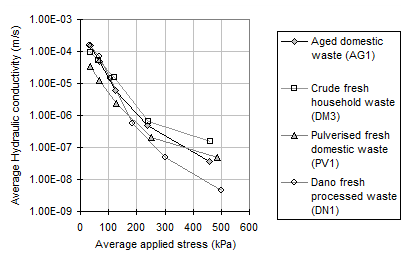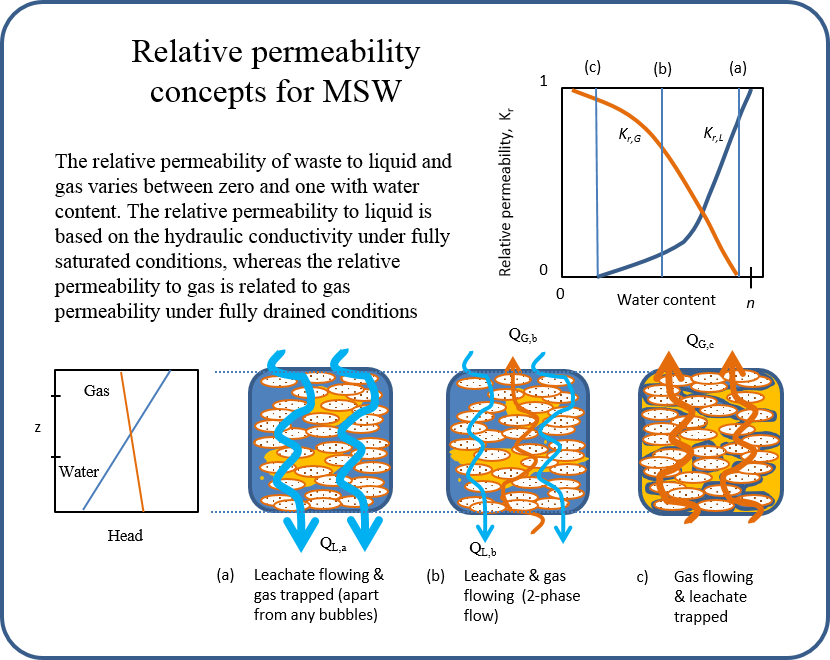Hydraulic conductivity of landfilled waste
The hydraulic conductivity (K) of a porous media (like waste) is a measure of the ability of the material to transmit fluid when subjected to a hydraulic gradient.
Introduction
The original hydrogeological definition of hydraulic conductivity relates to the passage of water through saturated porous media, and this concept still underpins much of the science relating to the hydraulic conductivity of waste. The hydraulic conductivity of a saturated waste is defined by Darcy’s law and has the same units as that for velocity. Typically, the hydraulic conductivity of saturated waste is expressed in units of m/s (metres/second).
However, waste in landfill is rarely fully saturated with the majority of flow occurring in the unsaturated zone above the leachate table. This introduces the need for unsaturated flow hydraulics to be included in any discussion about hydraulic conductivity.
Even within the nominally saturated zone, landfill gas formation will create bubbles of gas that will exist within the void space preventing the waste from being fully saturated. If gas bubbles are small and uniformly distributed throughout the liquid, and do not move independently of it, flow might still reasonably be treated as single phase with a permeant fluid of reduced density.
Within the oil and gas industry, the concept of hydraulic conductivity (which only relates to the flow of water) has been replaced by the use of intrinsic permeability. Intrinsic permeability separates out the characteristics of the porous media from that of the fluid flowing through it, thereby simplifying the calculation of the flow of fluids with different densities and viscosities. The concept of intrinsic permeability has relevance to landfills, particularly with the flow of landfill gas, but also potentially to the flow of leachates with significantly different characteristics to water.
Other factors that are important in any consideration of hydraulic conductivity include waste anisotropy and preferential flow.
Saturated hydraulic conductivity
Various authors have collated data from field and laboratory based studies on the hydraulic conductivity of MSW. Hydraulic conductivities of MSW reported in the literature vary between approximately 1x10-3 m/s and 1x10-9 m/s, although more typically values are in the range 10-5 to 10-6 m/s.
A number of factors control the hydraulic conductivity of waste. Waste composition is important, but for compressible MSW type wastes the degree of compaction, or the density of the waste in the ground is usually the most dominant controlling influence. Where waste has not been pre-compacted, the effective stress which is related to the depth of burial controls waste density.
In a series of large scale tests on the hydraulic conductivity of MSW carried out in the Pitsea compression cell (e.g.Powrie and Beaven 1999), the following observations were made.
1. There is a single correlation between the logarithm of the vertical hydraulic conductivity and vertical effective stress in first loading. Differences in hydraulic conductivity resulting from particle size reduction and waste degradation are essentially second order, but appear to become more significant at higher vertical effective stresses. The implication of these findings is that there will often be a reduction in hydraulic conductivity with depth in a landfill.

2. The relationship between hydraulic conductivity and dry density appear to be well defined but are different for individual waste types. A number of authors have taken a systematic approach to investigating the relationship between waste density hydraulic conductivity, in variously sized oedometer type apparatus. These studies are summarised below and indicate that the individual nature of the relationship between hydraulic conductivity and dry density is consistent.

Further data on measured values of the hydraulic conductivity of waste materials is provided in the properties database.
Unsaturated hydraulic conductivity

